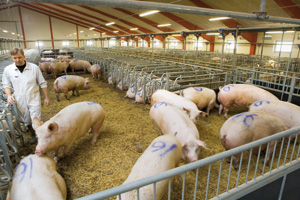Bringing home the bacon

Danish bacon exports to the UK have a relatively small impact on the environment, according to the Scandinavian country’s meat industry.
The Danish Meat Association is the latest organisation to respond to claims that buying food with fewer food miles is more environmentally friendly.
Henrik Lauritsen, quality assurance manager at the DMA, said Denmark, which exports 90% of its production, had not been specifically targeted by food miles campaigners but wanted to be prepared following criticism of exports from countries like New Zealand.
“We needed to have some ammunition and wanted to know where we are from an independent point of view so we can respond to our customers.”
According to research commissioned from Aarhus University, using internationally accepted Life Cycle Assessment analysis, transporting pork from Danish slaughterhouses to the UK accounts for only 1.5% of the total greenhouse gases emitted during the production chain.
“Transport is not an environmental hot spot,” said independent researcher Randi Dalgaard.
Most of the Danish pork consumed in the UK arrived by boat via Harwich, which helped reduce emissions, said Mrs Dalgaard. “Ships are very environmentally friendly. If you transport long distances by trucks then you do have a problem.”
Mrs Dalgaard said the most greenhouse gases in the pig-production chain were produced by growing the grain and soya used as feed.
In terms of pig rearing, she said manure was the biggest greenhouse-gas contributor. This was followed by energy used in the pig sheds and slaughterhouse.

In total, every kg of Danish pork consumed in the UK contributed the equivalent of 3.5kg of CO2 to the environment – equivalent to a nine-kilometre car journey.
Pig farmers could lessen substantially their impact on the environment by increasing production and feed conversion efficiency, said Mrs Dalgaard. She said the Danish pork industry was aiming to increase the number of pigs weaned per sow by 10% before 2015, while cutting the amount of feed by 10%.
Danish farmers already wean just over 26 piglets per sow each year, compared with 21.5 in the UK and 24.5 in Holland. It takes 264kg of feed to produce 100kg of Danish pork and 270kg in the UK.
But manure handling was the real environmental hotspot for pig producers in Denmark, said Mrs Dalgaard. Farmers have to comply with tight restrictions on slurry spreading, which has pushed up average land values to over £20,000/ha (£8093/acre), with land in the main pig-producing areas worth £27,000/ha (£10,926/acre).
Anybody with over 120 animal units (four sows and piglets) must own at least 30% of the land required to spread their manure, with one hectare needed for every 1.4 livestock units. Any residual land required can be leased for about £100/ha (£40/acre) from a neighbouring farmer, but there must be a formal agreement.
New or expanding units must first be assessed by the local authority and this process can take as long as five years. These restrictions can be eased for farmers prepared to install biogas plants, said Jørgen Hinge of the Danish Agricultural Advisory Service, but cost and local opposition meant very few had been built recently.
Fifty-seven plants have been constructed on larger units, said Mr Hinge, but only two of these had been built since 2001 when government incentives were removed.
“We do get a lot of calls from farmers, but we have to tell them that it won’t be feasible.”
A rise in the price paid for the electricity generated by the plants (currently about 6p per kWh) would be needed before they became financially viable, he reckoned.
